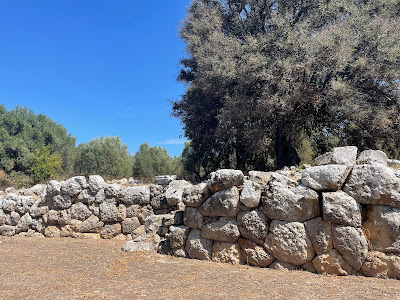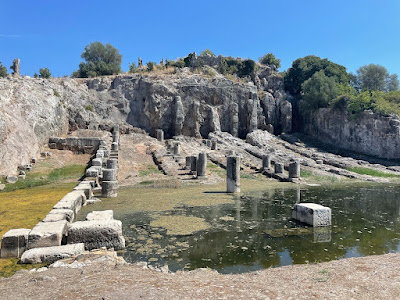The town of Oeniadae is first mentioned by Thucydides writing in the 5th century BC. He describes it as surrounded by the River Achelous to the point where it was almost an island. In fact, Oeniadae was on the delta of the river, where it runs into the Ionian Sea. Visiting now, it is difficult to imagine that, as the river course and coastline have changed and the site is around seven kilometres inland.
The settlement took advantage of a small hill and the marshes of the delta to provide a good defensive position and its importance as a port soon grew. Walls were built to protect the city, probably in the 5th century BC. The location, on the route to Corcyra (Corfu) and near the mouth of the Corinthian Gulf, meant that it became one of the most important towns of ancient Acarnania. This led to the city being coveted by the neighbouring Aetolians and other city states further afield, and consequently the target of military aggression. In order to protect itself, the city had to repeatedly change its loyalties and alliances.
Thucydides tells us that around 454BC Oeniadae was the object of an Athenian expedition under Pericles, which failed to capture the city. The Athenians had marched into the Peloponnese, taken Sicyon and pushed on to Oeniadae, but had to withdraw.
When the Peloponnesian War erupted in across Greece in 431 BC, the city was a member of the Peloponnesian League and an ally of Sparta. The winter of 429/8 saw Oenidae being the only Acarnanian city to hold out against the Athenians. The Acarnanians, backed by an Athenian naval force, attacked the city the next summer, yet still Oeniadae held out.
In the long term, however, their independent position was unsustainable and in 424, under pressure from the Acarnanians, they allied with Athens and became part of the Delian League. The city was valuable as a naval station, and was used by the Athenians, post Peloponnesian War, as a base for patrolling the Corinthian Gulf.
The Acarnanians’ neighbours, the Aitolians, were described by Thucydides as ‘numerous and warlike’. At that point they had not yet urbanised but were tribal peoples who ‘yet dwelt in unwalled villages scattered far apart’ and the Greeks of the southern city states considered them barbarous.
The three tribes of Aitolia came together in a League following the Battle of Chaeronea (338) in which the Macedonians and their allies defeated a coalition of Greek city states led by Athens and Thebes.
It was about this time that the Aitolians captured Oeniadae. They settled it with their own citizens and exiled the inhabitants of Oeniadae, making them refugees and forcing them to be taken in by other cities or to find a way to live elsewhere. The 4th century saw many Greeks forced to move from their city states due to overpopulation, with the men often seeking service as mercenaries in the Persian Empire, a problem which was only solved following the conquests of Alexander the Great when the East was opened up for Greek settlers.
However, in 324 Alexander decreed that all exiles from the Greek city states were allowed to return to their home polis. This affected many states, but none more than Athens and the Aitolian League, who would both have to surrender territory.
The Aitolians received a direct threat from Alexander, who told them that they would not have to wait for the Epigoni, the offspring of the men of Oeniadae, as he himself would come and inflict the punishment. In fact, Alexander did not live to carry out this threat, and following his death in 323 the Athenians and other city states, including the Aitolians, rose in revolt against the Macedonians, resulting in the Lamian War (323-322).
The Athenian confederacy had initial success against Antipater and the Macedonians, but after the start of the siege of the city of Lamia the Aitolian contingent left the siege and returned home, after telling the Athenian commander Leosthenes that it was necessary for their nation. Unfortunately, we do not know what this emergency was, but Bosworth surmises that it may have been because a Macedonian fleet had arrived in the vicinity of Oeniadae and the nearby Echinades Islands.
The Macedonians prevailed, both on land and in two naval actions; in the first the Athenian fleet was defeated off the Echinades Islands opposite Oeniadae, and in the second at Amorgos in the Cyclades in 322. The Acarnanians regained possession of Oeniadae that year, and the city became an important member of the Acarnanian League. Citizens from Oeniadae held important posts within the League during the first half of the 3rd century BC.
Around 260BC, the Aitolians retook the city, and it remained under their control until it was taken by Philip V of Macedon in 219BC and declared free. Philip realised the importance of the strategic position of Oeniadae, and he strengthened its fortifications and in particular the harbour area. The well-preserved ship sheds are attributed to this period of building.
The Aitolians took advantage of their alliance with Rome in 211 BC to wrest control of Oeniadae from Macedon and once Greece was under Roman control the city lost its strategic importance.
The archaeological site
The walls of the city, which have a circuit of over 5 kilometres, may date back as far as the 5th century BC. They are made of large blocks of stone, cut to shape to fit together without any bonding, and with towers at intervals. Some of the towers date to the time of Philip V, as do the harbour fortifications and the ship sheds, though it is possible that there may have been some kind of structure here before – Polybius tells us that Philip ‘surrounded the harbour and ship sheds with a wall’. The harbour was entered by an arched gate and overlooked by a tower which is still well preserved.
The ship sheds comprise six ramps cut from the bed rock. We can assume that stone excavated from the site to make the shed was used for the refortification of the harbour walls, though much of the stone for the walls comes from quarries up river and floated down the Achelous to the city. There are colonnades between the ramps to support the wood beam and tiled roof.
The spaces between the colonnades are between 5 and 6 metres wide and the ramps are over 40 metres long. This give us useful information about the size of the triremes that could be pulled up into the sheds. The sheds were used to protect ships and to do minor repairs, but are too narrow for shipbuilding. In use, the ramps would have been timbered and greased and hauling gear used to pull the ships up out of the water. Warships were often hauled out of the water when not in use, and kept under cover so that their hulls would not rot.
Within the city, there are the remains of a small theatre with 27 rows of seats. The remains of the stage building, which was colonnaded, can be seen, as well as sockets between the columns for scenery panels to be attached. The theatre dates back to the 4th century BC, though the remains of the stage and the orchestra seen today seem to be later. Inscriptions on the first few rows of seats record manumissions. On the first row it is possible to make out ‘Andronikos set free Onasimos, Phyllo, Onasikles and Philista.’
Further Reading
Blackman, D., Rankov, B., Shipsheds of the Ancient Mediterranean
Cambridge University Press, 2014
Bosworth, B., Why did Athens lose the Lamian War?
in The Macedonians in Athens, Eds., Palagia, O., Tracy, S.V.
Oxbow Books, 2003
Habicht, C., Athens, Samos, and Alexander the Great
Proceedings of the American Philosophical Society
Vol. 140, No. 3 (Sep., 1996), pp. 397-405
Morrison, J.S. and Coates, J.F., Greek and Roman Oared Warships
Oxbow Books, 1996





Fascinating the difference between settling such disputes at that time in the north and south of the Mediterranean
ReplyDelete